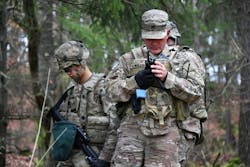Army asks industry for new protective soldier gear for wearable electronics, power, and data distribution
NATICK, Mass. – U.S. Army researchers are asking industry for new soldier-worn equipment to support wearable electronics, power and data distribution, and to protect the warfighter from bugs, bullets, infrared sensors, and even enemy radar.
Officials of the Army Contracting Command in Natick, Mass., issued a sources-sought notice on Friday (01760-5011) for the Soldier Combat Protective Ensemble (CAPE) project.
Researches are trying to identify companies that can integrate technologies related to soldier body-worn protection, survivability, and distribution of power and data. The Army Contacting Command is issuing this notice on behalf of the Army Combat Capabilities Development Command (CCDC) Soldier Center in Natick, Mass.
Related: Military wearable computing hits the mainstream
The CAPE project focuses on the soldier of 2030 and will develop and demonstrate new soldier body-worn technologies for infantry rifle platoons and squads. The project's goals are to demonstrate
-- reductions in overall size and weight of soldier body-worn equipment;
-- soldier signature management;
-- environmental protection; and
-- ballistic and blast protection; and soldier body-worn distribution of power and data.
The Soldier Center envisions two developmental systems -- one for temperate and tropical environments, and the other for cold and arctic conditions.
For environmental protection, researchers want equipment to protect the soldier from mosquitos, ticks, mites, and other insects; provide thermal and moisture management; to assist with camouflage and concealment -- including low detection from infrared sensors and battlefield radar.
The new gear also should help the soldier carry loads like wearable computers, sensors, ammunition, food, and water -- including the ability to carry at least 1.5 gallons of water with built-in purification technologies. Equipment also should have body armor to protect soldiers from blasts, fragmentation, and small firearms.
This equipment also should integrate a power and data distribution on the soldier, with the ability to attach several digital electronic devices to a central common interface.
Related: Wearable electronics adapt to the infantry
Soldier-worn electronic devices for integration may include batteries; tactical radios; wearable computers; GPS receivers; displays; wearable sensors; power generation; power management; and weapons.
Companies interested should email white paper no later than 1 May 2020 to the Army's Mary Prebensen at [email protected] and to Shaun Filocamo at [email protected].
Email questions or concerns to Mary Prebensen at [email protected] and to Shaun Filocamo at [email protected].
The Army expects to issue formal requests for proposal for the CAPE project early next year. Contracts awarded should run from 2021 to 2025. More information is online at https://beta.sam.gov/opp/147e0180b65f494e804a2994569e2b4a/view.

John Keller | Editor-in-Chief
John Keller is the Editor-in-Chief, Military & Aerospace Electronics Magazine--provides extensive coverage and analysis of enabling electronics and optoelectronic technologies in military, space and commercial aviation applications. John has been a member of the Military & Aerospace Electronics staff since 1989 and chief editor since 1995.

